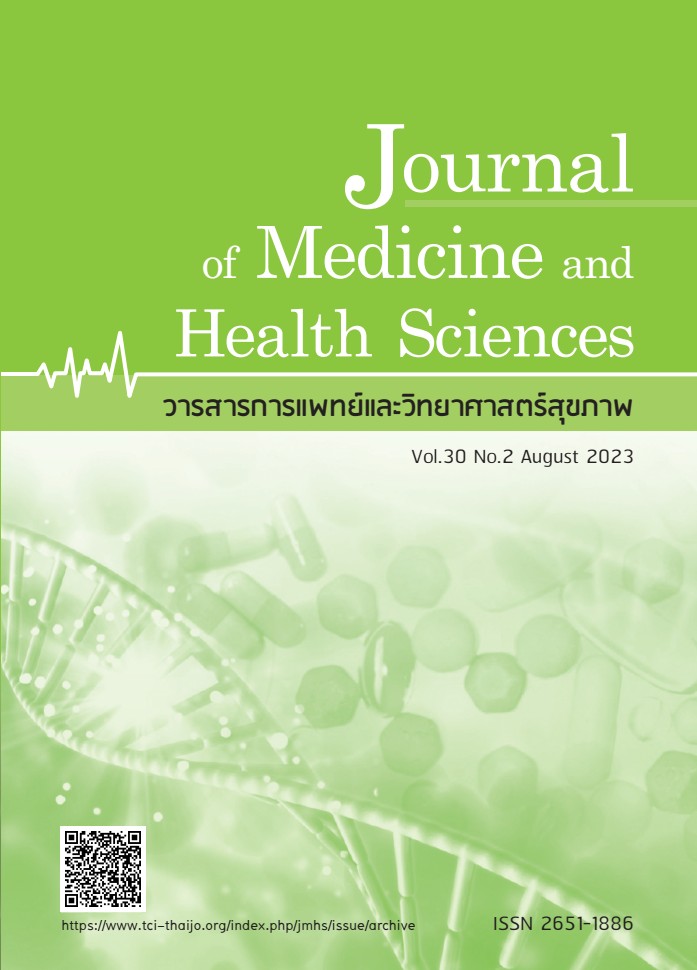Correlation between modified computed tomography classification and chronic subdural hematoma progression
Keywords:
chronic subdural hematoma, burr hole, modified CT classificationAbstract
Chronic subdural hematoma (CSDH) is a common neurosurgical condition. Although surgical treatment is often successful, conservative treatment have continuously increased the chances of a successful outcome. The aim of the present review is to collect existing data on pathophysiology of CSDH, using cranial computed tomography (CT) to predict the progression of a hematoma. From January 2015 to April 2021, a retrospective and descriptive study was conducted in Panyananthaphikkhu Chonprathan Medical Center in Nonthaburi, Thailand. An inventory was taken from all patients diagnosed with CSDH. The patients were evaluated according to Modified CT classification. All patients initially received a brain CT scan. The studied variables were demographic characteristics, including underlying diseases, a history of head trauma and hematoma volume on follow-up brain CT scan. This included 80 patients with CSDH 97 lesions. They were classified into five groups according to modified CT classification: homogenous type (n=44), laminar type (n=13), gradation type (n=19), separated type (n=10), and trabecular type (n=11). The study showed that the gradation type was significantly related with a progression of subdural hematoma size at the one-month follow-up of brain scan (odd ratio = 6.61, 95% confidence interval = 1.61 - 27.08). A gradation type of CSDH on CT scan was the strongest predictor of hematoma progression, while a history of prior head trauma and dyslipidemia were also related to the progression of CSDH.
References
Feghali J, Yang W, Huang J. Updates in chronic subdural hematoma: epidemiology, etiology, pathogenesis, treatment, and outcome. World Neurosurg 2020;141:339-45.
Rust T, Kiemer N, Erasmus A. Chronic subdural haematomas and anticoagulation or anti-thrombotic therapy. J Clin Neurosci 2006;13(8):823-7.
Beck J, Gralla J, Fung C, et al. Spinal cerebrospinal fluid leak as the cause of chronic subdural hematomas in nongeriatric patients. J Neurosurg 2014;121(6):1380-7.
Baechli H, Nordmann A, Bucher HC, et al. Demographics and prevalent risk factors of chronic subdural haematoma: results of a large single-center cohort study. Neurosurgical review 2004;27(4):263-6.
Markwalder TM. Chronic subdural hematomas: a review. J Neurosurg 1981;54(5):637-45.
Santarius T, Kirkpatrick PJ, Ganesan D, et al. Use of drains versus no drains after burr-hole evacuation of chronic subdural haematoma: a randomised controlled trial. Lancet 2009;374(9695):1067-73.
Almenawer SA, Farrokhyar F, Hong C, A et al. Chronic subdural hematoma management: a systematic review and meta-analysis of 34,829 patients. Ann Surg 2014;259(3):449-57.
Weigel R, Hohenstein A, Schlickum L, et al. Angiotensin converting enzyme inhibition for arterial hypertension reduces the risk of recurrence in patients with chronic subdural hematoma possibly by an antiangiogenic mechanism. Neurosurgery 2007;61(4):788-92.
Kageyama H, Toyooka T, Tsuzuki N, et al. Nonsurgical treatment of chronic subdural hematoma with tranexamic acid. J Neurosurg 2013;119(2):332-7.
Wada M, Yamakami I, Higuchi Y, et al. Influence of antiplatelet therapy on postoperative recurrence of chronic subdural hematoma: a multicenter retrospective study in 719 patients. J Clin Neurosci 2014;120:49-54.
Nakaguchi H, Tanishima T, Yoshimasu N. Factors in the natural history of chronic subdural hematomas that influence their postoperative recurrence. J Neurosurg 2001;95(2):256-62.
Takei J, Hirotsu T, Hatano K, et al. Modified computed tomography classification for chronic subdural hematoma features good inter-rater agreement: A single-center retrospective cohort study. World Neurosurgery 2021;151:e407-17.
Ito H, Yamamoto S, Komai T, et al. Role of local hyperfibrinolysis in the etiology of chronic subdural hematoma. J Neurosurg 1976;45(1):26-31.
Lee KS. Natural history of chronic subdural haematoma. Brain Inj 2004;18(4):351-8.
Downloads
Published
How to Cite
Issue
Section
License

This work is licensed under a Creative Commons Attribution-NonCommercial-NoDerivatives 4.0 International License.



